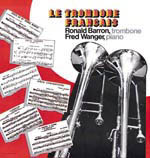

LE TROMBONE FRANCAIS
Boston Brass Series BB-1001CD


With Fredrik Wanger, piano.
CD CONTENTS
Morceau Symphonique (1902): Alexander Guilmant (1837-1911)
Cavatine Opus 144 (1915): Camille Saint-Saens (1835-1921)
Piece Concertante Opus 27 (1910): Carlos Salzedo (1885-1961)
Piece en Mi Bemol Mineur (1907): Joseph-Guy Ropartz (1864-1955)
Capriccio(1957): Roger Boutry (b. 1932)
La Femme a Barbe "du Tableaux Forains" (1958): Jose Berghmans (b.1921)
Deux Danses (1954): Jean-Michel Defaye (b. 1932)
REVIEWS
International Trombone Association Newsletter, Volume III, No. 1 September 1, 1975
Le Trombone Francais, Ronald Barron, trombone, Fredrik Wanger, piano
Guilmant: Morceau Symphonique. St.-Saens: Cavatine. Salzedo: Piece Concertante. Ropartz: Piece en Mi Bemol Mineur. Boutry: Capriccio. Berghmans: La Femme A Barbe. Defaye: Deux Danses.
In this first release of the Boston Brass Series, Ronald Barron, the newly appointed Principal Trombonist of the Boston Symphony Orchestra, displays a great command of his instrument and the music of a style period that encompasses the romantic, impressionistic and early 20th century traditions.
The literature is from the French school of composers that produced pieces to be performed as examinations at the Paris Conservatory.
Overall this is an excellent production; however, technically there seems to be an imbalance at times between the level of the piano and trombone. Even though Mr. Wanger performs extremely well throughout the album as a musical partner, I would have liked to have heard more piano when the duo was performing.
Musically, I was most impressed with the performances of the Ropartz, Salzedo, and Defaye and this may be partly because of the compositions and their projection by the two artists. Ron Barron is a performer with a "mucho bravura" style and projects music on this basis. In the compositions with a more romantic tendency, such as the Guilmant and St.-Saens, this writer felt that there could have been a little more expression and subtlety. One might think in this style period about tension and it's release. The contrast of "La Femme A Barbe", on the other hand, was an utter delight to hear.
This record is one of the finest additions to the library of trombone literature and much praise should go to Ron Barron for this production, especially since this recording was sandwiched in between his already busy schedule with the BSO, teaching and other performances.
We all hope with the next record (soon I hope) that other literature will be investigated. For instance, if French literature is continued it should include Bozza, Casterede, and Tomasi, just to name a few. (John R. Marcellus)
High Fidelity Magazine, August 1976
Boston Brass is a new independent label run by Ronald Barron, who has recently risen in the ranks to first trombone with the Boston Symphony. Hopes are high to record and issue more offbeat recitals by first-chair BSO brass players. Meanwhile, three of the younger members of that section are part of the Empire Brass Quintet, whose first record is due shortly from Columbia.
If trombone recitals don't crop up every day, it may have something to do with the scantiness of good music for that instrument. (It's not all that easy to write gratefully for) Surprisingly, none of the material here is transcriptions and some of it is strikingly appealing. Joseph-Guy Ropartz (1864-1955) was evidently a very solid product of the French Romantic school, and his Piece breathes the darkly agitated mood of (with something close to a thematic quote from) Franck's piano quintet. The Boutry Cappriccio is a catchy, often syncopated work of considerable rhythmic lability, and the Sacred and Profane Dances of Defaye are imposingly sonorous. Saint-Saens Cavatine is perhaps of less interest than these. All the works are written with obvious flair for the instrument.
Barron is a consummately skillful virtuoso. (He plays two different trombones here) The record is well named, for aside from the ethnic roots of the composers I would characterize the renditions as Gallic in style (judging from the one comparison I could make with another recording, Henry Smith's more weighty and Germanic version of the Guilmant Morceau Symphonique on Columbia MS 6791) Fredrik Wanger is a capable accompanist, and the acoustics of the auditorium at the Boston Conservatory, on whose faculty Barron teaches, are highly congenial. The pressing is first-rate, and my only complaint is that the space on the jacket could have been used for more information rather than bilingual notes of a more general nature. ......A.C.
